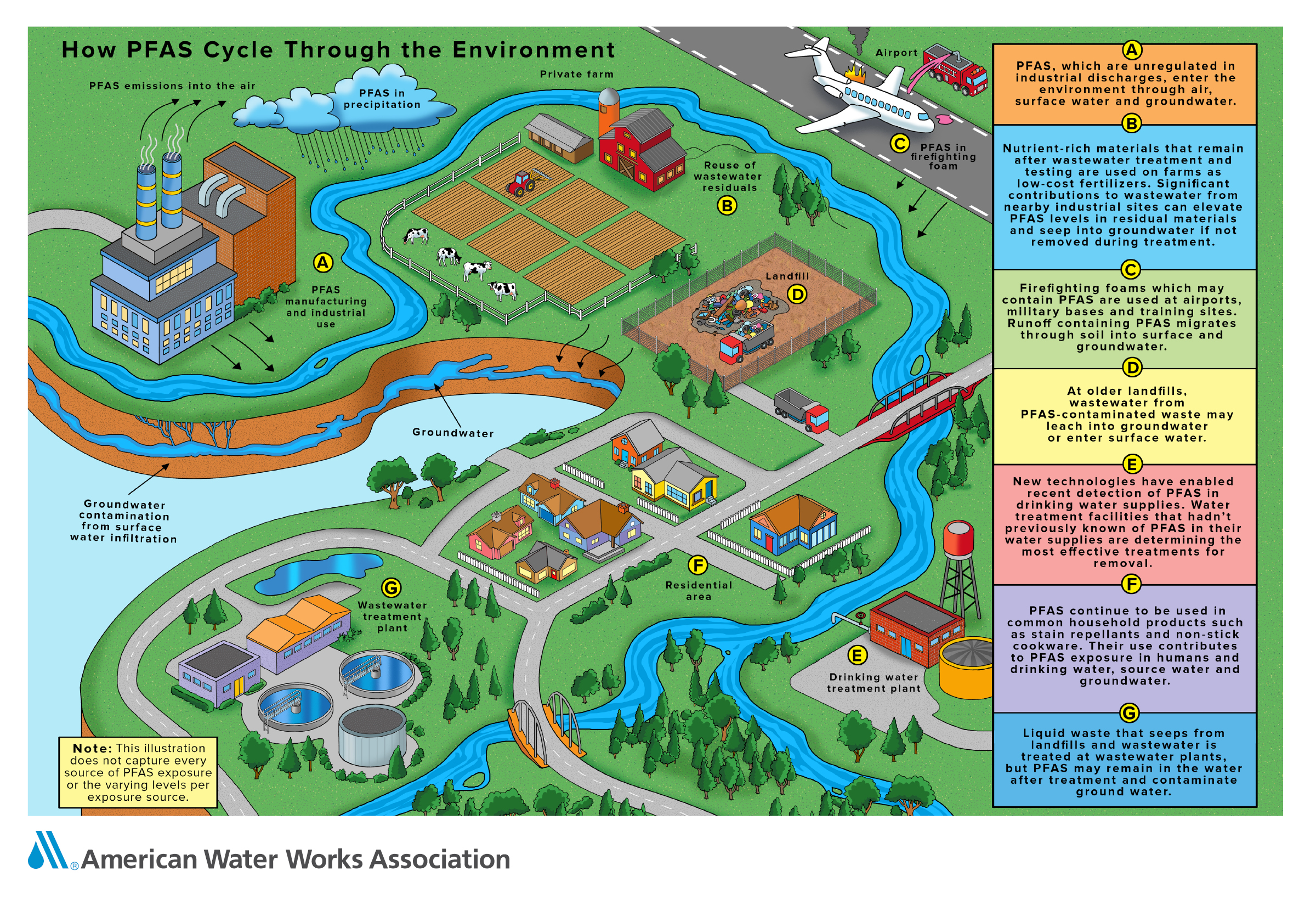The Environmental Protection Agency (EPA) has introduced permanent regulations to limit harmful PFAS "forever chemicals" in drinking water nationwide. PFAS, a group of synthetic chemicals that do not decompose in the environment, can lead to health problems for individuals and environmental damage. You can learn more about PFAS and our proactive monitoring of these substances.
What are PFAS?
Per- and polyfluoroalkyl substances (PFAS) are a family of more than 46,000 synthetic organofluorine chemicals (compounds containing carbon-fluorine bonds). Owing to their resistance to heat, oils, and water, these chemical compounds are used in household items ranging from non-stick cookware to dental floss and waterproof clothing to microwave popcorn bags. Unfortunately, the same traits that make them useful also prevent them from degrading quickly, or at all, spurring the nickname “forever chemicals.” Their persistence in the environment can affect the health of both the environment and water users. The EPA has identified some health risks and exposure factors, and has made that information available here.
to their resistance to heat, oils, and water, these chemical compounds are used in household items ranging from non-stick cookware to dental floss and waterproof clothing to microwave popcorn bags. Unfortunately, the same traits that make them useful also prevent them from degrading quickly, or at all, spurring the nickname “forever chemicals.” Their persistence in the environment can affect the health of both the environment and water users. The EPA has identified some health risks and exposure factors, and has made that information available here.
How Does PFAS Enter Water and the Environment? 
PFAS typically enter surface waters through sites where they are made, used, disposed of, or spilled. PFAS are also very mobile and easily transported through rainwater runoff.
How these chemicals get into groundwater is still being studied, but they most likely enter by seeping through soil and into groundwater sources. PFAS can also enter water sources from the Aqueous Film Forming Foam (AFFF) used for firefighting at military bases, airports, and fire stations.
What is TWC Doing to Protect Drinking Water?
In 2021, The Texas Water Company (TWC) conducted a risk assessment to identify significant points of entry for PFAS (per- and polyfluoroalkyl substances) into their surface and groundwater sources. The evaluation focused on the immediate surface area as well as the Trinity Aquifer in the regions outside of TWC’s service area. The study was especially concerned about the potential impacts of military installations situated around San Antonio. Fortunately, the report concluded that no significant risks were identified at that time. However, to proactively monitor for PFAS, TWC began a voluntary sampling program in May 2022. The program aims to take PFAS samples across all its systems using the same methodology and area sample sites approved by the Environmental Protection Agency (EPA).
It is important to note that TWC’s voluntary sampling program differs from the sampling performed under the EPA’s Unregulated Contaminant Monitoring Rule (UCMR) program. The UCMR program is conducted to assist the EPA in identifying drinking water quality risks. In the third round of UCMR (2013-2015), eight of TWC’s groundwater wells and one of its surface water plants were tested for PFAS, but no PFAS was detected. In addition to its own sampling program, TWC will participate in the upcoming round of UCMR scheduled between 2023 and 2025, including PFAS sampling.
Can PFAS be Removed from Drinking Water?
Currently, treatment options are limited and the options that are available do not treat all compounds in the PFAS family. Identifying what types of PFAS may be in the water is a critical first step in addressing any problems should they arise. This is another reason TWC is performing voluntary sampling - so that it can work to stay ahead of any challenges posed by PFAS.
Related Media Coverage
- EPA - First-Ever National Drinking Water Standard to Protect 100M People from PFAS Pollution
- AP News - Biden administration sets first-ever limits on so-called ‘forever chemicals’ in drinking water
- CBS News - EPA announces first-ever national regulations for "forever chemicals" in drinking water
- New York Times - E.P.A. Says ‘Forever Chemicals’ Must Be Removed From Tap Water
- Washington Post - In a first, EPA sets limit for ‘forever chemicals’ in drinking water
- Forbes - EPA Finalizes First-Ever National Limits On ‘Forever Chemicals’ In Drinking Water
- NBC News - EPA imposes first national limits on 'forever chemicals' in drinking water
- Wall Street Journal - What to Know About the EPA Limits on ‘Forever Chemicals’ in Drinking Water and Your Health
